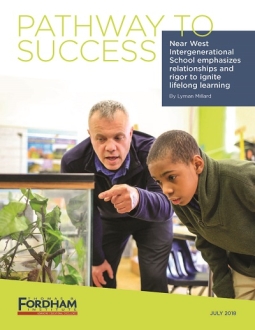Editor’s note: Fordham President Michael J. Petrilli recently published a long-form article titled, “Where Education Reform Goes from Here.” Others have responded to that essay, and this post furthers that conversation.
Mike Petrilli’s next steps for the education reform movement essentially boil down to staying the course on choice and accountability, improving curriculum, and reworking the career track in high schools. There’s more nuance, of course, but in a nutshell that’s it.
I say go big. It’s time for a new civil rights movement with educational equity as the centerpiece.
We will never close achievement gaps under the current framework. Low-income kids will always start school further behind than their middle-class counterparts, they will always get shafted on funding, and they will never catch up in the vast majority of schools.
Setting aside politics for the moment, what is really needed to dramatically change outcomes is much more learning time and much more investment in teachers.
Start at the beginning—literally—with programs providing support for low-income kids from birth through preschool. There is no better investment than strong early learning programs. If we really want to make a difference, that’s the place to start.
Second, radically reduce class size in the lower grades. Let’s get K–3 teacher-student ratios down to fifteen-to-one or less in schools serving poor children, and then we will find out if we can teach them all to read by third grade.
For the middle grades I support most of what Mike has suggested, especially a more content-rich curriculum, but I would be much more aggressive about improving teaching and diversifying the teaching corps.
First off, I support higher pay for teachers and a higher bar for tenure. We should also make teaching a year-round job with summers devoted to tutoring kids who are behind and upgrading and honing teaching skills.
In a system where white students are now a minority, a teaching profession that is over 80 percent white is educationally unacceptable. Regardless of a student’s race, any kid who goes through thirteen years of schooling and encounters only a handful of teachers of color, at most, is simply not prepared to function in an increasingly diverse, globalized society.
Now we get to high school, where at least a quarter of low-income kids don’t graduate and only a third of all graduates of any income are college-ready. And we all know that we’re not doing a good job training young people to go right into the job market.
I don’t support Mike’s proposal for a gateway test. That will almost certainly lead to tracking low-income kids and kids of color away from college. No one’s life choice should be dictated by a test given in tenth grade.
But high schools could function more like Montessori schools where the students, teachers, and parents direct the learning. Mike hints at this concept with his section on “personalized pacing,” but I would go further to personalized high school education.
We should be very clear about what colleges look for. And if kids and parents really want college, they should choose the appropriate courses. You will not become an engineer without lots of math. You will not get into MIT if you spend all your time in art class.
We should be equally clear about what employers look for and build a curriculum that meets those needs. You will not work in coding without computer skills. You will not work in the construction trades without basic carpentry.
We should also offer a lot more online learning in high school. As those of us in the work-world know, self-directed learning is the skill we use every day doing online research to help inform our decisions. The one thing all people need to succeed is the ability to figure out for themselves how to solve problems, and it borders on criminally negligent in this day and age to graduate anyone from high school without basic computer literacy.
Needless to say, this would cost a lot more than we are spending today, which is in the neighborhood of $650 billion. While there might be modest savings if we offer more online learning in high school, universal early learning programs, smaller classes in the lower grades, and higher teacher pay will probably bring the tab closer to a $1 trillion.
Moreover, we need to spend considerably more money teaching poor kids than wealthy ones, which requires targeting more state and federal funding towards low-income kids. I recently argued for a much bigger federal investment by shifting dollars from defense to education—which is the real defense industry of the twenty-first century.
At the state level, we’re only now catching up to pre-recession (2008) spending levels in a majority of states. That’s not nearly enough. States have a moral obligation and an economic interest in lifting our low-income kids into the middle class through education.
Even from a cost-benefit analysis, the more money we spend on education, the less we will spend on social costs, policing, incarceration, and preventable health problems. Fundamentally, education is America’s best bet, and the states that act on it will prevail.
As for the politics, it will be a big lift unless we can build a true multiracial economic movement that unites everyone in the bottom 80 percent of the country to demand a fairer distribution of our wealth. That’s the new civil rights movement, and like the old civil rights movement, it starts in the classroom.
The views expressed herein represent the opinions of the author and not necessarily the Thomas B. Fordham Institute.



